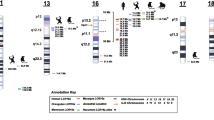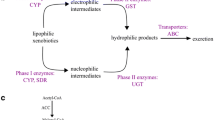Abstract
The class III POU transcription factor genes play an important role in the nervous system. Comparison of their entire amino acid sequences disclosed a remarkable feature of particular mammalian class III POU genes. Alanine, glycine, and proline repeats were present in the mammalian Brain-1 gene, whereas most of these repeats were absent in the nonmammalian homologue. The mammalian Brain-2 gene had alanine, glycine, proline, and glutamine repeats, which were missing in the nonmammalian homologue. The mammalian Scip gene had alanine, glycine, proline, and histidine repeats, but the nonmammalian homologue completely lacked these repeats. In contrast, the mammalian Brain-4 gene had no amino acid repeats like its nonmammalian homologue. The mammalian genes containing the characteristic amino acid repeats had another feature, higher GC content. We found a positive correlation between the GC content and the amino acid repeat ratio. Those amino acids were encoded by triplet codons with relatively high GC content. These results suggest that the GC pressure has facilitated generation of the homopolymeric amino acid repeats.
Similar content being viewed by others
References
Agarwal VR, Sato SM (1991) XLPOU1 and XLPOU2, two novel domain genes expressed in the dorsoanterior region ofXenopus embryos. Dev Biol 147:363–373
Atanasoski S, Toldo SS, Malipiero U, Schreiber E, Fries R, Fontana A (1995) Isolation of the human genomic Brain-2/N-Oct 3 gene (POUF3) and assignment to chromosome 6g16. Genomics 26:272–280
Baltzinger M, Payen E, Remy P (1992) Nucleotide sequence of XLPOU3 cDNA, a member of the POU domain gene. Nucleic Acids Res 20:1993
Bernardi G (1993) The isochore organization of the human genome and its evolutionary history—a review. Gene 135:57–66
Billin AN, Cockerill A, Poole SJ (1991) Isolation of a family ofDrosophila POU domain genes expressed in early development. Mech Dev 34:75–84
Bürglin TR, Finney M, Coulson A, Ruvkun G (1989)Caenorhabditis elegans has sources of homeobox-containing genes. Nature 341: 239–243
De Kok YJM, Van der Maarel SM, Bitner-Glindzicz M, Huber I, Monaco AP, Malcolm S, Pembrey ME, Ropers HH, Cremers FPM (1995) Association between X-linked mixed deafness and mutations in the POU domain gene POU3F4. Science 267:685–688
Duboule D (1994) Guidebook to the homeobox genes. Sambrook and Tooze Publication at Oxford University Press, Oxford
Douville PJ, Atanasoski S, Tobler A, Fontana A, Schwab ME (1994) The brain-specific POU-box geneBrn4 is a sex-linked transcription factor located on the human and mouse X chromosomes. Mamm Genome 5:180–182
Faus I, Hsu H, Fuchs E (1994) Oct-6: a regulator of keratinocyte gene expression in stratified squamous epithelia. Mol Cell Biol 14:3263–3275
Fukuta M, Hui C, Matsuno K, Nagata T, Takiya S, Suzuki Y (1993) Molecular cloning of a POU domain-containing factor involved in the regulation of theBombyx sericin-1 gene. J Biol Chem 268: 19471–19475
Hara Y, Rovescalli AC, Kim Y, Nirenberg M (1992) Structure and evolution of four POU domain genes expressed in mouse brain. Proc Natl Acad Sci USA 89:3280–3284
He X, Treacy MN, Simmons DM, Ingraham HA, Swanson LW, Rosenfeld MG (1989) Expression of large family of POU-domain regulatory genes in mammalian brain development. Nature 340:35–42
He X, Gerrero R, Simmons DM, Park RE, Lin CR, Swanson LW, Rosenfeld MG (1991) Tst-1, a member of the POU domain gene family, binds the promoter of the gene encoding the cell surface adhesion molecule Po. Mol Cell Biol 11:1739–1744
Herr W, Sturm RA, Clerc RG, Corcoran LM, Baltimore D, Sharp PA, Ingraham HA, Rosenfeld MG, Finney M, Ruvkun G, Horvitz HR (1988) The POU domain: a large conserved region in the mammalianpit-1,oct-1,oct-2, andCaenorhabiditis elegans unc-86 gene products. Genes Dev 2:1513–1516
Higgins DG, Bleasby AJ, Fuchs R (1992) CLUSTAL V: improved software for multiple sequence alignment. Comput Appl Biosci 8:189–191
Huber I, Bitner-Glindzicz M, De Kok YJM, Van der Maarel SM, Ishikawa-Brush Y, Monaco AP, Robinson D, Maocolm S, Pembrey ME, Brunner HG, Cremers FPM, Ropers H (1994) X-linked mixed deafness (DFN3): cloning and characterization of the critical region allows the identification of novel microdeletions. Hum Mol Genet 3:1151–1154
Johnson WA, Hirsh J (1990) Binding ofDrosophila POU-domain protein to a sequence element regulating gene expression in specific dopaminergic neurons. Nature 343:467–470
Le Moine C, Young III SW (1992) RHS2, a POU domain-containing gene, and its expression in developing and adult rat. Proc Natl Acad Sci USA 89:3285–3289
Li P, He X, Gerrero MR, Mok M, Aggarwal A, Rosenfeld MG (1993) Spacing and orientation of bipartite DNA-binding motifs as potential functional determinants for POU domain factors. Genes Dev 7:2483–2496
Mathis JM, Simmons DM, He X, Swanson LW, Rosenfeld MG (1992) Brain 4: a novel mammalian POU domain transcription factor exhibiting restricted brain-specific expression. EMBO J 11:2551–2561
Matsuzaki T, Amanuma H, Takeda H (1992) A POU-domain gene of zebrafish, ZFPOU1, specifically expressed in the developing neural tissues. Biochem Biophys Res Commun 187:1446–1453
Meijer D, Graus A, Kraay R, Langevelt A, Mulder MP, Grosveld G (1990) The octamer binding factor Oct6: cDNA cloning and expression in early embryonic cells. Nucleic Acids Res 18: 7357–7365
Mitchell PJ, Tjian R (1989) Transcriptional regulation in mammalian cells by sequence-specific DNA binding proteins. Science 245: 371–378
Monuki ES, Kuhn R, Weinmaster G, Trapp BD, Lemke G (1990) Expression and activity of the POU transcription factor SCIP. Science 249:1300–1303
Orii H, Agata K, Watanabe K (1993) POU domain genes in planarianDugesia japonica: the structure and expression. Biochem Biophys Res Common 192:1395–1402
Rosenfeld MG (1991) POU-domain transcription factors: pou-er-ful developmental regulators. Genes Dev 5:897–907
Saitou N, Nei M (1987) The neighbor-joining method: a new method for reconstructing phylogenetic trees. Mol Biol Evol 4:406–425
Sambrook TH, Fritsche EF, Maniatis T (1989) Molecular cloning: a Laboratory Manual. 2nd ed. Cold Spring Harbor Laboratory Press, Cold Spring Harbor, NY
Schreiber E, Tobler A, Malipiero U, Schaffner W, Fontana A (1993) cDNA cloning of human N-Oct 3, a nervous-system specific POU domain transcription factor binding to the octamer DNA motif. Nucleic Acids Res 21:253–258
Suzuki N, Rohdewohld H, Neuman T, Gruss P, Schöler HR (1990) Oct-6: a POU transcription factor expressed in embryonal stem cells in the developing brain. EMBO J 9:3723–3732
Verrijizer CP, Van der Vliet PC (1993) POU domain transcription factors. Biochim Biophys Acta 1173:1–21
Weissenbach J, Gyapay G, Dib C, Vignal A, Morissette J, Millasseau P, Vaysseix G, Lathrop M (1992) A second-generation linkage map of the human genome. Nature 359:794–801
Witta SE, Agarwall VR, Sato SM (1995) X1POU2, a noggin-inducible gene, has direct neutralizing activity. Development 121:721–730
Xia YR, Anderson B, Mehrabian M, Diep AT, Warden CH, Mohandas T, McEvilly RJ, Rosenfeld MG, Lusis AJ (1993) Chromosomal organization of mammalian POU domain factors. Genomics 18: 126–130
Zimmerman EC, Jones CM, Fet V, Hogan BLM, Magnuson MA (1991) Nucleotide sequence of mouse SCIP cDNA, a POU-domain transcription factor. Nucleic Acids Res 19:956
Author information
Authors and Affiliations
Additional information
Correspondence to: S. Ueda
Rights and permissions
About this article
Cite this article
Sumiyama, K., Washio-Watanabe, K., Saitou, N. et al. Class III POU genes: Generation of homopolymeric amino acid repeats under GC pressure in mammals. J Mol Evol 43, 170–178 (1996). https://doi.org/10.1007/BF02338824
Received:
Accepted:
Issue Date:
DOI: https://doi.org/10.1007/BF02338824




